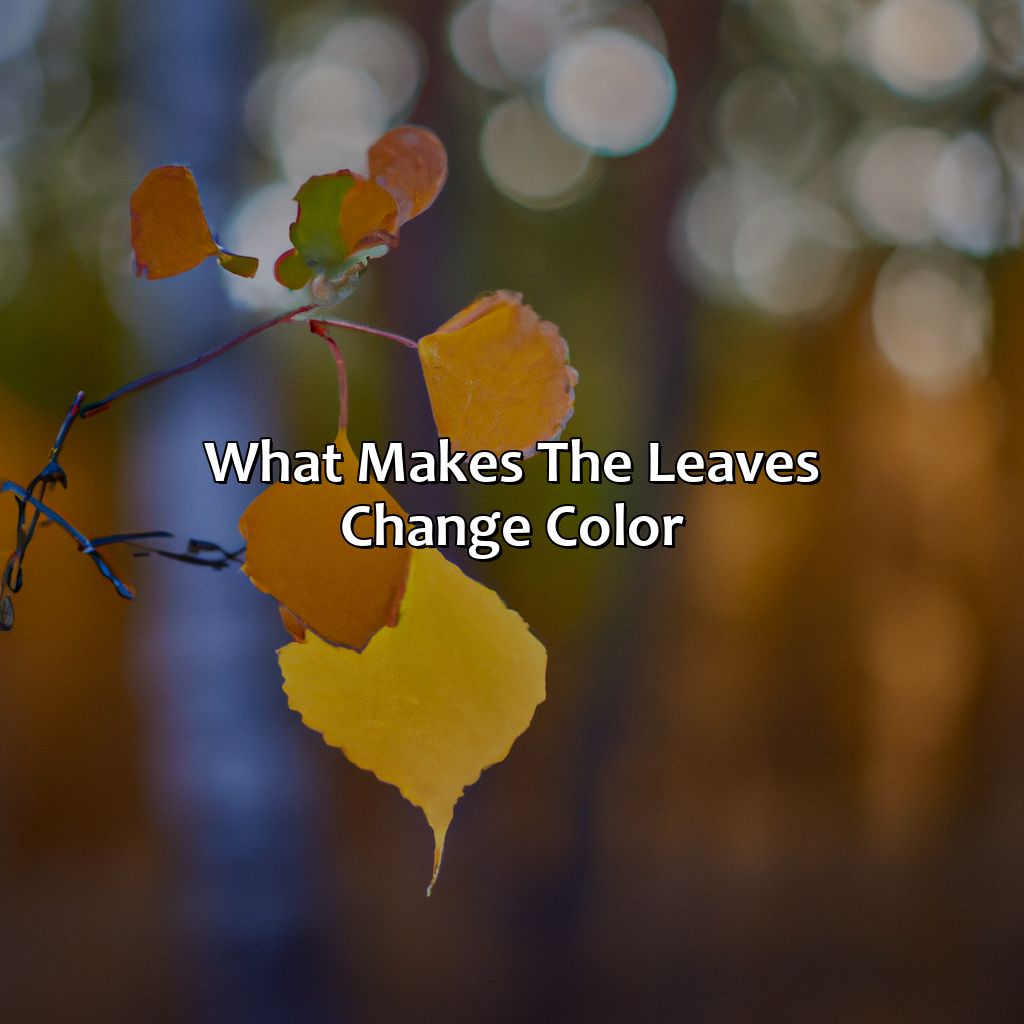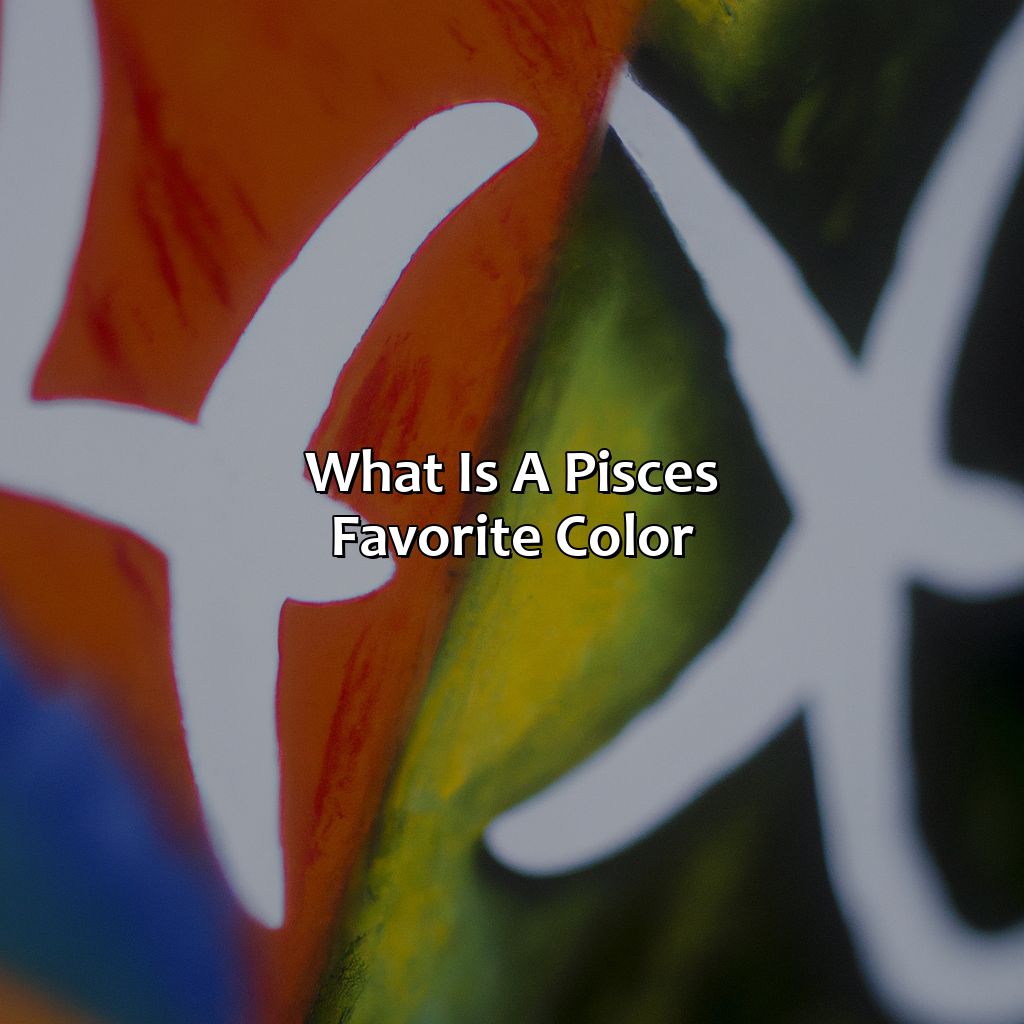Key Takeaway:
- The color of mushrooms varies greatly depending on the species, with colors ranging from yellow to black.
- Mushroom cap color and stem color are two factors that influence the appearance of mushrooms.
- The color of mushrooms can be affected by genetics, environmental factors, and the presence of toxins.
The Different Colors of Mushrooms
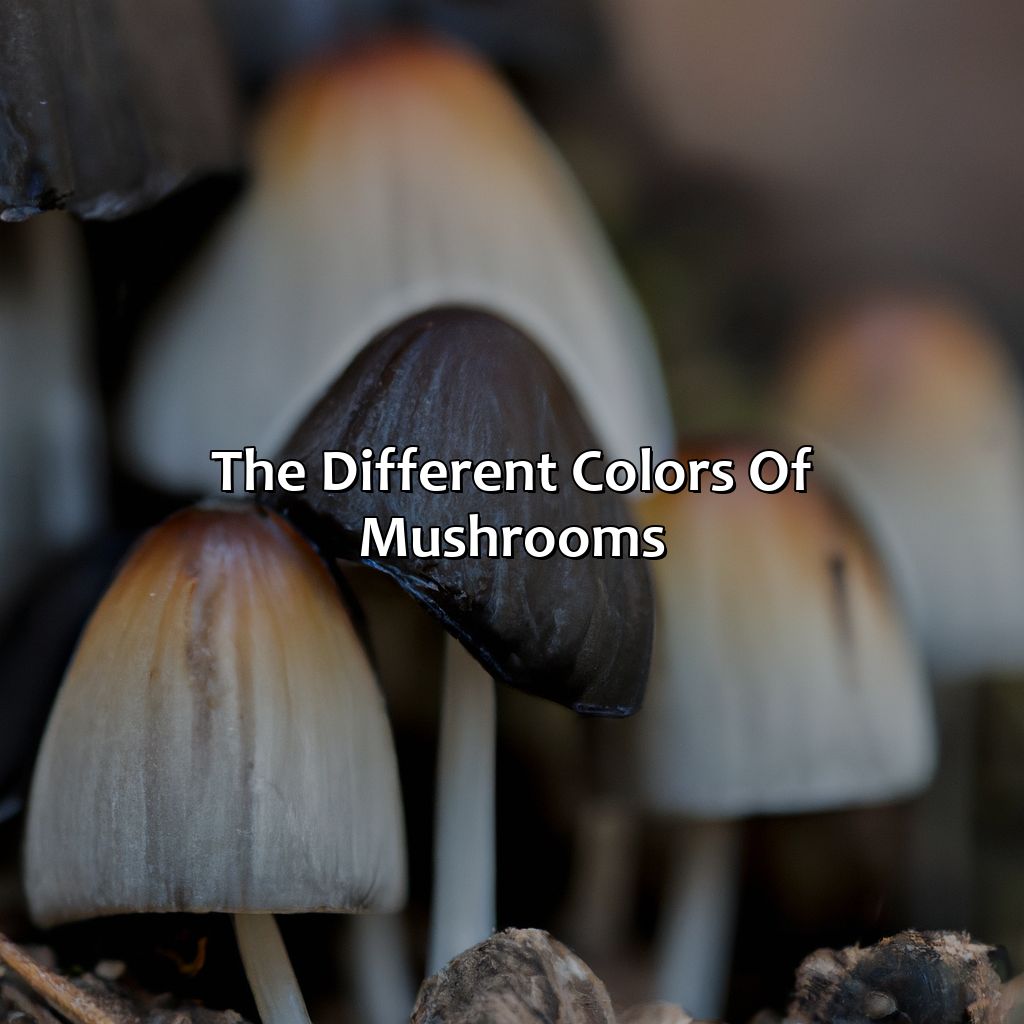
Photo Credits: colorscombo.com by Tyler Thomas
This section has many subsections for exploring the diverse colors of mushrooms. You can forage and cook yellow mushrooms, which have a yummy flavor. Meanwhile, red mushrooms are risky due to their toxicity. White mushrooms add new flavors to meals. Gourmet dishes have green mushrooms, blue and purple mushrooms require special care when growing, and black mushrooms have medicinal properties.
Yellow Mushrooms
Yellow-Colored Mushrooms in Nature and Cuisine
Mushroom foraging enthusiasts know that yellow mushrooms are some of the most interesting and sought-after fungal species out there. Here are some unique characteristics and culinary uses of different yellow-colored mushrooms:
| Mushroom | Characteristics | Culinary Uses |
|---|---|---|
| Chanterelle | Bright yellow, trumpet-shaped caps with wavy margins; fruity aroma; meaty texture. | Sautéed as a side dish; used in risottos, pasta sauces, omelets, and soups. |
| Chicken of the Woods | Fan-shaped fruiting bodies with overlapping scales; sulfur-yellow on top, white underneath; lemony flavor; fibrous texture. | Pan-fried as a vegan substitute for chicken; added to stir-fries, curries, and tacos. |
| Yellowfoot or Winter Chanterelle | Smaller, flatter version of chanterelles; pale yellow-brown cap with a lighter stem; peppery scent; slightly chewy texture. | Roasted or grilled as a side dish; used in frittatas, quiches, salads, and stews. |
Mushroom hunters should be careful not to confuse golden chanterelles with the false chanterelle (Hygrophoropsis aurantiaca), which is orange-yellow but has gills instead of ridges under its cap.
When cooking with yellow mushrooms, a few tips can help retain their natural flavors and textures. First, avoid washing them under running water; instead, brush off any dirt or debris with a soft brush or cloth. Second, cook them over high heat in a dry pan before adding any liquid, to prevent them from becoming soggy. Third, pair them with complementary flavors such as garlic, herbs, and butter.
Yellow mushrooms are just one of the many colorful and delicious fungi that can add depth and complexity to mushroom-based recipes. The next section explores brown-colored mushrooms and their features.
Brown mushrooms may not be the most exciting hue, but their culinary potential will leave your taste buds begging for more.
Brown Mushrooms
Mushrooms of a particular variety have distinct features, with each type exhibiting varying colours. Examining Brown Mushrooms, they are characterized by a tinge of dark brown in their cap and stem, intensifying as it ages.
- Brown mushrooms rank amongst some of the most common edible fungi worldwide.
- Their dense texture makes them a perfect addition to cream-based sauces or gravies.
- Brown mushrooms are also well-suited for baking and grilling.
- These mushrooms match well with meat-based dishes due to their rich flavour profile.
- Brown button mushrooms are a popular ingredient among mushroom-lovers in the kitchen.
Distinctively, Brown Mushrooms can be consumed raw but suitably cook well even sliced thinly like onions on pizzas.
Incorporating Brown Mushrooms into mushroom cuisine is advised as this particular type has been accumulated with valuable nutrients. Constructing dishes that encompass such foods not only present phenomenal garnishing options but would ensure one maintains an overall healthy diet.
Discover the endless culinary possibilities involving brown mushrooms, avoid being left out on savory delicacies!
Red mushrooms: the perfect gift for your worst enemy’s backyard.
Red Mushrooms
| Common Name | Scientific Name | Edible/Poisonous |
| Fly Agaric | Amanita muscaria | Poisonous/Hallucinogenic |
| Bleeding Mycena | Mycena haematopus | Edible (sometimes mild poison) |
| Blood-Red Waxcap | Hygrocybe punicea | Edible but rare/health benefits debated |
There are several types of red mushrooms, including Fly Agaric and Bleeding Mycena. Blood-Red Waxcaps can also be found with varying shades of red on their caps.
Don’t miss the opportunity to explore unique options for mushroom identification through understanding not just color but also other identifying features such as scent or stem texture in order to make safe edible choices.
Who needs white lies when you can have white mushrooms in your favorite recipes?
White Mushrooms
White mushrooms are one of the most popular culinary mushrooms, known for their mild flavor and versatile nature. They belong to the Agaricus bisporus species, which also includes crimini and portobello mushrooms. In terms of appearance, white mushrooms have a smooth, firm cap that ranges from white to light brown in color.
| Scientific Name | Agaricus bisporus |
| Taste | Mild and slightly earthy |
| Texture | Firm and smooth |
| Cooking methods | Frying, sautéing, roasting, grilling, baking, soups/stews. |
Not only are they delicious when cooked fresh, but they can also be used in various dishes including salads and pizzas as well as in soups and stews for added flavor. White mushrooms grow naturally in forests and grasslands but are primarily cultivated globally on commercial farms.
Interestingly, white mushrooms gained popularity during World War II when farmers were trying to make use of the waste generated by soybean production. They began growing them on a large scale under darkened conditions using artificial light to keep up with consumer demand during that time.
In summary, white mushrooms are a staple ingredient in culinary dishes known for their mild flavor profile and versatile nature. Their popularity surged during World War II due to an increase in demand for fresh produce. With its numerous culinary possibilities and globally available supply via commercial farming projects, it’s no wonder these fungi have earned their spot as one of the most-used culinary mushrooms worldwide.
Why settle for green juice when you can have green mushrooms? Elevate your gourmet game with this unique fungi.
Green Mushrooms
Mushrooms that exhibit green coloration possess unique taste, texture and nutritional benefits. Here’s a brief overview of the gourmet varieties of green mushrooms and their culinary uses.
| Mushroom Name | Scientific Name | Known for |
|---|---|---|
| Maitake | Grifola frondosa | Umami-rich and earthy flavor |
| Enoki | Flammulina velutipes | Crunchy texture and subtle sweetness |
| Chanterelle | Cantharellus cibarius | Peach-like aroma, nutty flavor |
These green mushrooms are also known to be rich in potassium, vitamin C and antioxidants.
Avoid overcooking these fungi to preserve their odor, texture and color. They pair well with ingredients like garlic, olive oil, soy sauce, and cheese.
Try sautéing or stir-frying green mushrooms with herbs like rosemary or thyme for added depth of flavor. Alternatively, add them to soups or stews as they absorb the other flavors of the dish.
Experiment with these unconventional mushroom varieties in your recipes for a unique twist on classic dishes.
Blue and purple mushrooms may look like they belong in a fantasy world, but with the right cultivation techniques, you too can have a magical garden of colorful fungi.
Blue/Purple Mushrooms
Blue and purple mushrooms are a rare, but intriguing sight in the world of mushroom cultivation. These mushrooms can range in color from blue-gray to deep violet, making them an elegant addition to any dish or decorative arrangement.
- Blue/purple mushrooms get their unique coloring from pigments called anthocyanins.
- Anthocyanins are typically produced when the mushrooms are exposed to ultraviolet light or intense heat.
- Some species of blue/purple mushrooms include Cortinarius semisanguineus and Lactarius indigo, among others.
- Blue/purple mushrooms have been used for medicinal purposes in traditional Chinese medicine.
- Blue/purple mushrooms can add both flavor and vibrancy to dishes like salads or stir-frys.
- In a decorative setting, blue/purple mushrooms can add a pop of color to any bouquet or centerpiece.
Interestingly, some species of blue and purple mushrooms also have psychoactive properties, leading them to be sought after by those looking for hallucinogenic experiences.
For those interested in cultivating blue and purple mushrooms, it’s important to note that these colors are uncommon and require specific environmental factors such as UV light exposure. Additionally, not all strains of blue and purple colored mushrooms are edible, so proper research is necessary before consumption.
To incorporate these unique colored fungi into meals suggest adding them into sauces for pasta dishes or use them as a colorful topping on an open-faced sandwich. Furthermore, incorporating them into stir-fry dishes or even pairing them with other vibrant vegetables creates both colorful plates and prime nutrients.
Black mushrooms may make you feel like you’re in a dark forest, but their medicinal properties will light up your health.
Black Mushrooms
- Black mushrooms contain high levels of antioxidants that can aid in reducing inflammation in the body.
- Some varieties of black mushrooms, such as the Black Truffle, have a strong earthy flavor that adds depth to dishes.
- These mushrooms are often used in Chinese medicine for their immune-boosting properties and for promoting healthy digestion.
In addition to their health benefits and culinary uses, black mushrooms also possess unique cultural significance, being an integral part of traditional Korean cuisine.
Pro Tip: Black mushrooms are delicate and require gentle handling when cooking. It is best to cook them over low heat to maintain their texture and flavor.
Mushrooms, like chameleons, can change their color according to their mood and environment.
Factors That Affect the Color of Mushrooms

Photo Credits: colorscombo.com by Sean King
To grasp why mushrooms come in different colors, you need to investigate the elements which influence their hue.
To learn more, we will investigate why mushrooms come in different colors with the following sub-sections:
- Genetics
- Environmental Factors
It explains how mushroom ecology and genetics have an effect on their color.
It looks into how different environmental components, like mushroom habitats and surrounding environment, can change their color.
Genetics
The variations in the color of mushrooms are not only due to environmental factors but also genetics. The genetic makeup determines the pigments, enzymes and proteins that determine the distinctive colors of mushrooms.
| Column 1 | Column 2 |
|---|---|
| Pigments | Carotenoids, flavonoids, betalains, phenolics, anthocyanins |
| Enzymes | Tyrosinase, laccase, polyphenol oxidase |
| Proteins | Leucocyanin, riboflavin-binding protein |
| Color Result | Yellow/brown (carotenoids), red/purple (anthocyanins), white (tyrosinase) etc |
The mushroom ecology greatly influences gene expression which produces distinctive colors, shapes, and texture based on adaptation to its growth environment.
Unique DNA mutations found across different species result in diversity of pigment genes expressed and hence their appearance.
To cultivate specific colors of mushrooms requires understanding the genetics and environmental cues that enable optimal growth conditions for each desired coloration. Suggestions involve careful monitoring of incubators by adjusting pH level among other things to promote a suitable cultivation environment for mushroom growth while maintaining genetic hue variability.
Even mushrooms have a ‘go green’ agenda, as their color can be affected by their environmental habitat.
Environmental Factors
The color of mushrooms can be influenced by various environmental factors, including temperature, humidity, soil conditions and light exposure. The environment plays a crucial role in determining the color of mushrooms because different types of mushrooms thrive in different habitats. For instance, chanterelle mushrooms which are yellow-orange in color grow in more acidic soil with a high concentration of dead leaves whereas shiitake mushrooms that are brown thrive in hardwood forests.
The amount of moisture in the environment also affects mushroom colors. Mushrooms that grow in humid areas are usually darker because they have more chlorophyll than those growing in dry environments. Besides this, mushrooms are photosensitive to light and tend to change their pigment when exposed to different degrees of illumination and duration.
Other factors such as air quality, levels of carbon dioxide as well as microorganisms present in the environment can also play a role in determining mushroom colors. Mushroom growers have been able to manipulate environmental conditions to alter the color of specific types, depending on consumer preferences.
It’s worth noting that changes or variations in environmental factors can lead to changes or variations in mushroom colors. Thus even within one type, let’s say an oyster mushroom- you might find varying shades based on where it was grown- so if you’re intrigued by these fungi and wish to add diversity and depth to your meals – always inquire about their origins!
Fun fact: Depending on how they’re prepared Shiitake mushrooms can change from being brownish-grey tones during a stir fry dish to having softer shades when added raw into salads! [source- Food Republic]
Add a pop of color to your mushroom cuisine with these cooking techniques for different colored mushrooms.
Culinary Uses of Different Colored Mushrooms
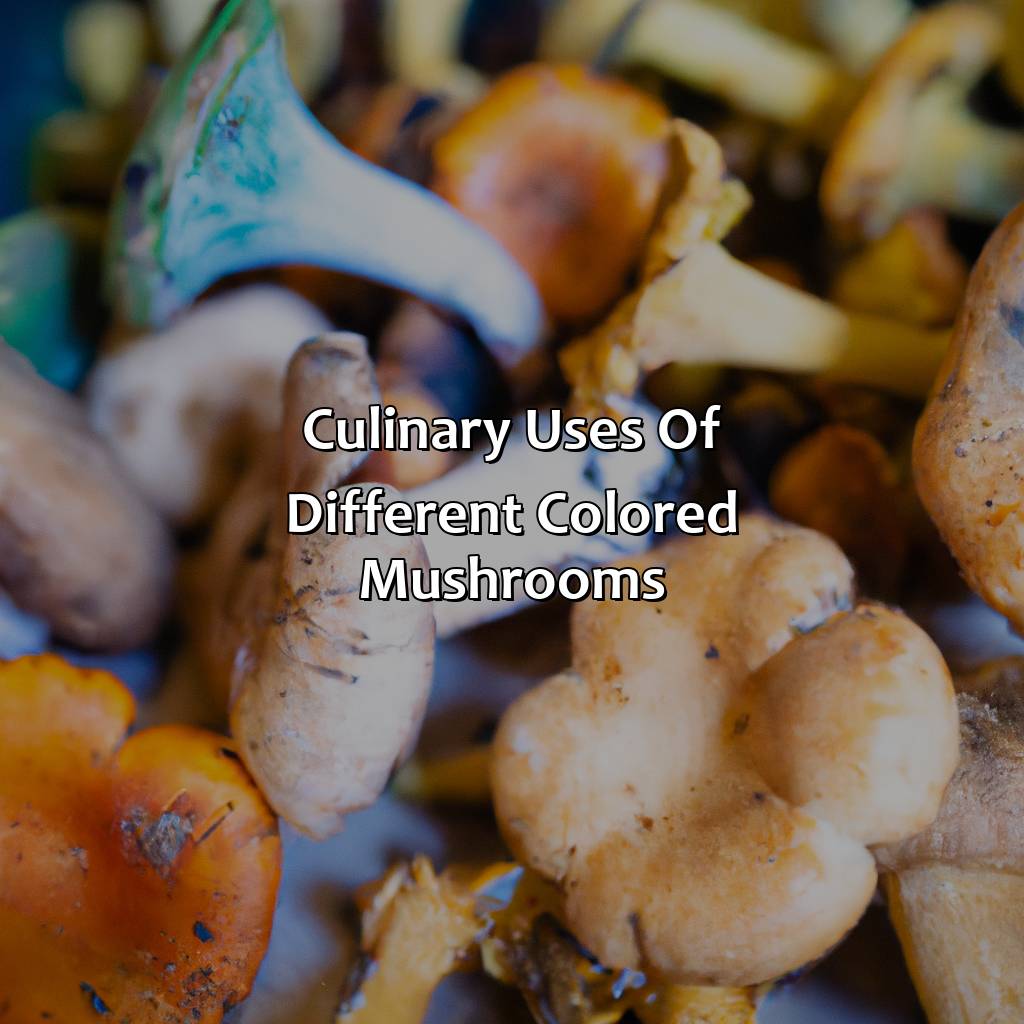
Photo Credits: colorscombo.com by Jordan Carter
Delve into the world of mushroom cooking! Discover delicious Yellow, Brown, Red, and White Mushroom recipes. Explore the exciting potential of mushrooms. Transform them into mouth-watering dishes with mushroom cookery. Enjoy!
Yellow Mushroom Recipes
Yellow Mushrooms: Culinary Delights
Explore the wonderful world of culinary mushrooms with our range of mushroom recipes. The yellow hue is a great indication of the rich and robust flavors lurking in these delicate creatures.
Indulge in the earthy flavors of yellow mushrooms with these four lip-smacking recipes:
- Roasted Yellow Mushroom Caps with Garlic and Herbs – A simple yet elegant dish that brings out the natural flavor of mushrooms, perfect as an appetizer or side dish
- Sautéed Yellow Mushrooms with White Wine Sauce – A perfect accompaniment for a hearty pasta or risotto dish
- Grilled Yellow Mushroom Skewers with Lemon Herb Marinade – An innovative blend of tangy lemon and pungent herbs work perfectly together to create this delectable dish
- Creamy Yellow Mushroom Soup – This creamy and velvety soup is ideal for chilly evenings or whenever comfort food cravings hit you!
Yellow mushrooms are known to have distinct characters like a meaty texture and nutty taste. They tend to absorb the flavors surrounding them, enhancing dishes’ overall richness.
Pro Tip: When cooking these particular fungi, opt for quick cooking methods instead of long slow ones to preserve their distinctive flavors and texture.
Get ready to impress your taste buds with these gourmet mushroom dishes featuring the versatile and delicious brown mushrooms.
Brown Mushroom Recipes
Brown Mushroom Delights for All Taste Buds
Savor some delectable gourmet mushrooms with these Brown Mushroom Delight recipes. Elevate your mushroom dishes in just a few easy steps.
- Stir-Fry Brown Mushrooms with Garlic and Butter
- Brown Mushroom and Rosemary Cream Sauce over Pasta
- Roasted Brown Mushroom Salad with Balsamic Vinaigrette
- Brown Mushroom Risotto with Parmesan Cheese
- Brown Mushroom Soup with Thyme and Sage
- Beef Stroganoff with Brown Mushrooms and Sour Cream Sauce
Try preparing these dishes to tantalize your taste buds, satisfying your desire for rich flavors.
Fascinatingly, brown mushrooms account for a significant amount of the world’s total production of mushrooms. They are known to have an earthy taste that complements several types of dishes, including soups, stews, and sauces.
One avid food enthusiast once tried brown mushroom stroganoff during a trip to Russia; he was so impressed with it that he had to try making it himself when he got back home. His family loved it so much that it has now become their staple family recipe.
Get ready to add some ‘fungi’ to your culinary repertoire with these tasty red mushroom recipes!
Red Mushroom Recipes
Red Mushrooms can add a unique flavor and color to your mushroom cuisine. These mushrooms are versatile and can be used in various dishes, from soups to stir-fries or as a topping for pizzas.
Some easy and delicious red mushroom recipes you can try are:
- Red Mushroom Risotto: A creamy risotto with sautéed red mushrooms, garlic, onion, and white wine.
- Mushroom Tart with Roasted Red Peppers: A savory tart with a pastry crust filled with red mushroom filling and topped with roasted red peppers.
- Red Mushroom Soup: A comforting soup made with sautéed red mushrooms, chicken broth, onions, cream, and white wine.
- Red Mushroom Stir-fry: A quick and easy stir-fry made with red mushrooms, garlic, ginger, red bell peppers, onions, and sesame oil.
It is essential to note that not all red mushrooms are safe for consumption. Some poisonous varieties like the Amanita Muscaria have bright red caps adorned with white spots. Always be cautious when selecting mushrooms for your mushroom cookery.
Pro-Tip: Always check the origin of the mushrooms you plan on cooking to ensure they are safe for consumption.
White mushrooms may be bland in color, but in dishes they are anything but dull – these culinary fungi are versatile and can add depth to any meal.
White Mushroom Recipes
White Mushrooms for Culinary Delights
Indulge in delectable dishes made from white culinary mushrooms with a mild yet earthy flavor.
- Enjoy a simple yet satisfying sautéed white mushroom side dish with chopped garlic and butter.
- Make creamy mushroom soup or a risotto using these versatile fungi as your base ingredient for an elevated dining experience.
- Add them to stir-fries, stews, or casseroles for a subtle nutty taste that complements other ingredients like meats and vegetables perfectly.
Did you know that white mushrooms are also rich in antioxidants and vitamin D? Enhance your health while savoring the fantastic flavors made possible by these essential mushroom dishes. Here’s some food for thought – consider adding white mushrooms as the star of your next meatless Monday meal.
Get ready to feast on these popular edible mushrooms all season long, but be warned, they may be so good you’ll never want to settle for basic white button mushrooms again!
Popular Edible Mushrooms and Their Colors
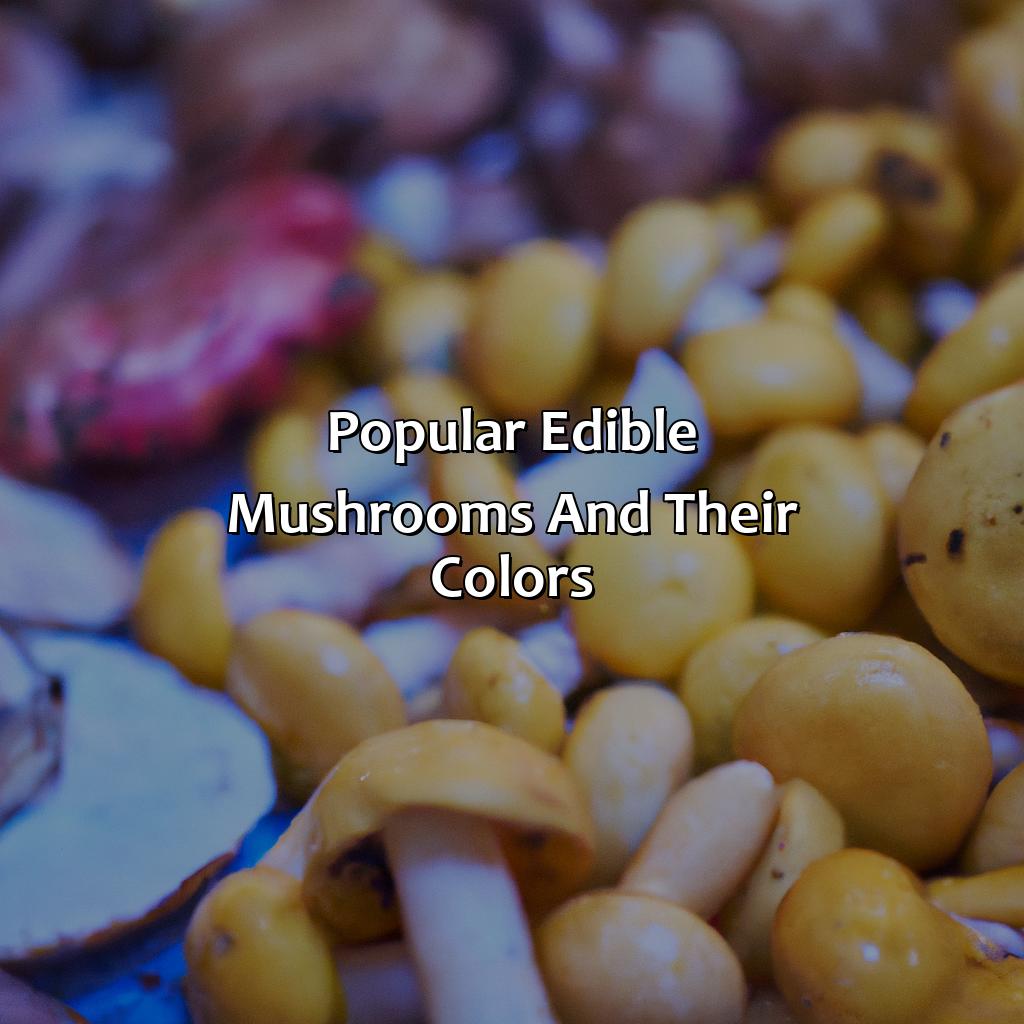
Photo Credits: colorscombo.com by Mark Lewis
Exploring the colors of mushrooms can help you learn more about edible ones. So, we created a guide! It contains information about four popular types: Portobello, Button, Shiitake, and Oyster. Discover how to use them in delicious mushroom dishes!
Portobello Mushrooms
Portobello mushrooms – A popular mushroom used in various mushroom dishes due to its distinct flavor and meaty texture.
- Large and flat with a dark brown cap, Portobello mushrooms are often used as a vegetarian substitute for meat in burgers or steaks.
- They have a rich flavor and can be grilled, sautéed, or roasted as a standalone dish or incorporated into salads, soups, and stews.
- Due to their size, they can also be stuffed with various fillings like cheese and herbs or used in pizzas as an alternative to traditional toppings.
- Portobello mushrooms also contain a variety of nutrients such as potassium, fiber, and vitamin B6.
Portobello mushrooms are highly versatile and widely used in various cuisines around the world. These fungi have been known to greatly enhance the taste of vegetarian dishes due to their unique texture and flavor profile. The history of using Portobello mushrooms dates back to ancient times when different cultures discovered the delicious taste they offered paired with their numerous health benefits.
Button mushrooms may be small, but they pack a flavorful punch in any dish.
Button Mushrooms
Button mushrooms belong to the species Agaricus bisporus and are the most commonly consumed mushroom worldwide. They have a smooth, white cap with a short stem and measure around 1-2 inches in diameter. Button mushrooms have a delicate, mild flavor that pairs well with many dishes. In culinary terms, they are considered versatile due to their ability to complement several seasonings and cooking styles.
When it comes to using button mushrooms in mushroom dishes, they work well in salads, stir-fries, soups, sauces, and stews. As they have a soft flesh texture, they cook relatively quickly and can be used for both primary and secondary ingredients due to their subtle taste.
An interesting fact about button mushrooms is that they are actually immature versions of larger mushrooms like portobello or cremini. As the mushroom ages, it changes its shape and color while gaining more earthy flavor notes.
Pro Tip: When preparing button mushrooms for mushroom dishes, it is essential to clean them properly by wiping them with damp paper towels instead of rinsing them under running water. This ensures that their delicate skin remains intact while preventing excess moisture from being absorbed during cooking.
Shiitake mushrooms: the fungus that’s worth shiita-king for in your dishes.
Shiitake Mushrooms
Shiitake Mushrooms, also known as Lentinula edodes, are commonly used in Asian cuisine and are a popular ingredient in mushroom dishes.
- One of the most cultivated mushrooms worldwide.
- Native to East Asia.
- Have a meaty texture and a smoky, earthy flavor.
- Packed with nutrients such as vitamin B and D, copper, and selenium.
- Research suggests that shiitake may have immune-boosting properties.
- Can be consumed fresh or dried for later use in soups, stir-fries, and stews.
Shiitake Mushrooms add depth of flavor to meals and provide numerous health benefits making them an excellent addition to any culinary repertoire.
Pro Tip: Fresh Shiitake Mushrooms can last up to one week if stored properly in a sealed container in the refrigerator.
Why settle for just one oyster when you can have a whole plateful in the form of delicious Oyster Mushroom dishes?
Oyster Mushrooms
Oyster Fungi: Characteristics and Culinary Applications
When it comes to the tasty Oyster Fungi, they’re a type of edible mushroom that has been enjoyed as a delicacy for years. Here are some characteristics of this popular ingredient:
- They have a subtle, delicate flavor that allows them to pair well with various dishes.
- Their cap is shaped like an oyster shell and varies in size and color depending on the variety.
- They are easy to cook and can be incorporated into numerous dishes such as stir fry, risotto, soup, and pasta.
- Oyster mushrooms are commonly used as flavorful substitutes for meat in vegan or vegetarian recipes.
- Similar to other mushrooms, oyster mushrooms have many nutritional benefits such as being rich in protein and antioxidants.
- Depending on how they are harvested, they can have varying degrees of texture which makes them highly versatile in cooking.
Interestingly, there are over 20 species of edible oyster fungi with some unique traits.
Research has shown that consuming more oyster mushrooms alongside other nutrient-dense foods may help improve health overall. (source: Journal of Medicinal Food)
Stay away from these colorful mushrooms, unless you want your last meal to be a trip to the ER.
Poisonous Mushrooms and Their Colors

Photo Credits: colorscombo.com by Anthony Sanchez
To recognize toxic mushrooms, this section looks at the colors of different types. Especially, Amanita mushrooms are notorious for being dangerous and False Morels can cause severe mushroom toxicity. Be aware!
Amanita Mushrooms
- Amanita Mushrooms have a distinct appearance with a cap that is usually white or yellow with patches of color.
- They possess a skirt-like ring on the stalk and a swollen base called the volva.
- They grow near trees, particularly oak and pine, and can emerge from the soil after rainfall.
- The toxic compounds in Amanita Mushrooms can cause liver failure, seizures, coma, and even death.
It’s important to know how to identify Amanita Mushrooms as mistaking them for edible mushrooms can have severe consequences. Mushroom hunters should always educate themselves on identifying toxic mushrooms before beginning their hunt. Once, a family of four went mushroom hunting and mistakenly collected Amanita Mushrooms for dinner. Within hours, they all suffered from acute liver failure and had to undergo liver transplants. It’s crucial to understand the risks associated with mushroom hunting and always verify any mushroom before consumption. Why settle for life when you can have a toxic mushroom experience with False Morels?
False Morels
Certain variations of mushrooms, referred to as false morels, can pose a significant threat to human health. False morels are often difficult to distinguish from edible mushrooms, such as the true morel species. Consumption of these toxic fungi is known to cause symptoms ranging from mild stomach upset to severe brain damage and death. It is essential to properly identify wild mushrooms before consuming them, as mushroom toxicity can have severe consequences.
False morels are characterized by their wrinkled and convoluted caps, which resemble an illusionary view of a brain when sliced longitudinally in half. Unlike true morels’ uniform cap structure and hollow stem construction, false morels contain multiple chambers in their stem that make them appear slightly wrinkled or marbled. These poisonous mushrooms usually grow under hardwood trees, emerging in the spring or summer months.
To avoid consuming false morels, it is recommended that people only purchase commercially grown mushrooms from trusted sources with verified safety regulations. Many grocery stores now carry fresh or dried cultivated mushrooms that are safe for consumption, but it’s always best to double-check with the seller before purchasing any wild-caught fungi.
If someone mistakenly ingests false morels or has consumed an unknown variety of mushroom, medical attention should be sought immediately for appropriate treatment measures. The severity and speed at which symptoms develop vary depending on the person’s age and immune system capabilities.
Five Facts About Mushroom Colors:
- ✅ Mushrooms come in a wide range of colors including white, brown, black, yellow, and red. (Source: The Spruce Eats)
- ✅ The color of a mushroom can change depending on maturity, habitat, and environmental factors. (Source: Everything Mushrooms)
- ✅ The gills of a mushroom can also vary in color. (Source: Mycological Society of San Francisco)
- ✅ Some poisonous mushrooms can be brightly colored, while others are more muted. (Source: Poison Control)
- ✅ The color of a mushroom can sometimes be used to identify the species, but other factors must be considered as well. (Source: Mushroom Appreciation)
FAQs about What Color Are Mushrooms
What color are mushrooms?
Mushrooms come in a variety of colors depending on the species. Some common colors include white, brown, gray, red, and yellow.
What causes mushrooms to change color?
Mushrooms can change color due to environmental factors such as sunlight, moisture, and temperature. Some species also change color as they mature.
Are there any poisonous mushrooms that are a certain color?
Yes, some mushrooms that are red or yellow can be highly toxic and should not be consumed. It is important to properly identify mushrooms before eating them.
What color are edible mushrooms?
Edible mushrooms come in a variety of colors including white, brown, and gray. Some popular edible species include button mushrooms, portobello mushrooms, and shiitake mushrooms.
Can mushrooms be artificially colored?
Some mushrooms can be artificially colored using food coloring or dyes. However, it is important to note that consuming artificially colored mushrooms may not be safe.
Do mushrooms change color when cooked?
Some mushrooms may change color when cooked due to the heat. For example, white button mushrooms may turn slightly yellow or brown when cooked.





